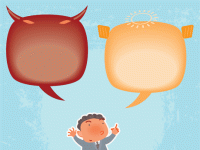Building Social and Emotional Skills in Elementary Students: Inner Meanie and Inner Friend
Your content has been saved!
Go to My Saved Content.In this nine-part series, we will look at important factors that influence the happiness and social and emotional learning of elementary school age children. These are very useful in helping students learn, manage emotions better and increase empathy. Each blog features one letter of the acronym HAPPINESS:
- H = Happiness
- A = Appreciation
- P = Passions and Strengths
- P = Perspective
- I = Inner Meanie/Inner Friend
- N = Ninja Mastery
- E = Empathy
- S = So Similar
- S = Share Your Gifts
In this post, we’ll explore the Inner Negative Meanie, the Inner Positive Friend and the choices that every student has.
Inner Negative Meanie
The Inner Negative Meanie is also known as the Inner Critic. It shows up as the voice that constantly puts us down. "You can never do it -- why even try? You're not good enough, not smart enough or just not enough, period!" The Inner Negative Meanie has so much power because, even if things go basically well, there's a tendency to focus on what did not. This is called the Negativity Bias. How does it work? Let's say you gave a presentation to 100 people. Ninety-eight people enjoyed it, but two said something that made you feel bad. The automatic tendency of most people (whether students or adults) is to focus on the very few negative comments instead of the many positive responses. It doesn't have to be this way!
Inner Positive Friend
In contrast, the Inner Positive Friend provides a self-compassionate framing that lends encouragement, calms our fears and sends soothing messages when things go wrong. The Inner Positive Friend would help you frame a situation this way: "I made a mistake, I'll learn from it -- that doesn't mean I'm a horrible person" or "Maybe I didn't do it perfectly, but I know if I practice more, I'm going to get better." Every person has a choice as to which voice they listen to and end up believing.
Fixed Mindset
Along the same lines, Carol Dweck explains that there are two types of mindsets we can adopt. The fixed mindset operates hand in hand with the Inner Negative Meanie. Students with a fixed mindset believe that their abilities and potential are fixed at birth. For example, they believe that they are either innately good at math or they are not. Questions like "Will I succeed or will I fail?" always arise. Someone with a fixed mindset would not want to risk trying something new for fear of failure and embarrassment. They tend to avoid challenges, get defensive or give up easily. This mindset does not promote resilience!
Growth Mindset and Resilience
The growth mindset works hand in hand with the Inner Positive Friend. Setbacks are seen as opportunities for growth and improvement. If you fall down, you pick yourself up again and move forward. Imagine a baby learning to walk. If she had a fixed mindset, she might say, "I've had it with this walking thing -- it's ridiculously hard, I look stupid -- I'm done!" With a growth mindset, the attitude is "I got up -- I took a step! I fell down -- OK, falling down is part of it -- I'm going for another step now!" Learning something new requires effort and practice, and overcoming challenges is just part of the journey. A student with a growth mindset who chooses to listen to his or her Inner Friend is much more resilient and can reach ever-higher levels of achievement.
Praising Process vs. Result
Adults can influence how young people look at their experiences, too. Praise is tricky. When offering praise, what if teachers or parents emphasized the effort involved in an activity rather than the result? When my daughter showed talent in art, in my excitement I told her, "You're a genius -- such talent! You are a born artist!" Lo and behold, instead of encouraging her, that stopped her in her tracks. When she was tired of the style she had excelled in, she did not want to even attempt anything new. A better approach would have been, "That drawing is so interesting; it looks like you put a lot of effort into it. What made you choose those colors?" She probably would not have felt such pressure to produce perfection. The good news is that her interest has rebounded, and we've both learned something important. Now she regularly taps into her Inner Positive Friend who eases the way.
Once students know that they can choose to shift their perspectives from negative feelings and thoughts to positive feelings and thoughts, they can exercise the choice to help themselves feel better. (Find lesson plans and additional resources at projecthappiness.org to learn more about this.) Students who learn at a young age that they have the power to select which messages they take in (from the Inner Positive Friend or the Inner Negative Meanie) will have a huge advantage in later years, too.
What related issues are your students facing and what has been helpful in your classroom?
